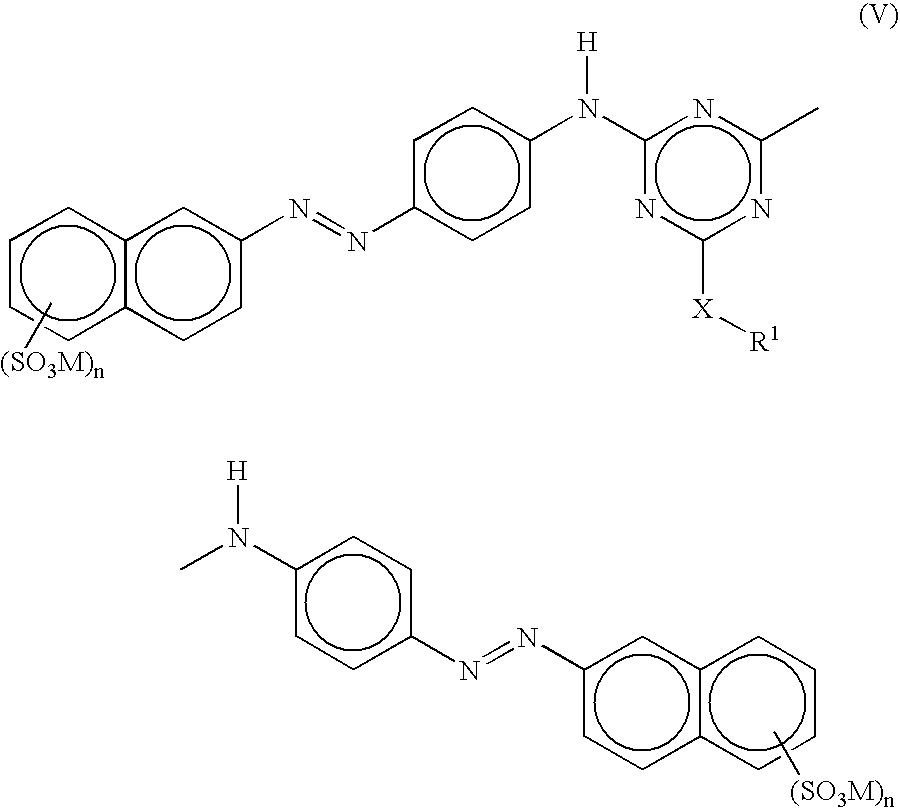Disazo dyes and their preparation and use
a technology of disazo dyes and dyes, which is applied in the field of yellow disazo dyes, can solve the problems that none of the commercially available combinations of recording liquids and nanoporous recording sheets and does not meet all the necessary requirements. , to achieve the effect of excellent light stability, excellent diffusion fastness and excellent resistance to degradation
- Summary
- Abstract
- Description
- Claims
- Application Information
AI Technical Summary
Benefits of technology
Problems solved by technology
Method used
Image
Examples
example 1
Preparation of the Intermediate Dye Compound
[0085]The intermediate dye compound of formula (XII)
was prepared in the following way:
[0086]614 g of the disodium salt of 3-[(4-aminophenyl)azo]-naphthalene-1,5-disulfonic acid (content 77.5%, 1.054 moles) were dissolved in 4900 ml of water at a temperature of 65° C. The warm solution (65° C.) was filtered through 20 g of silica gel under pressure. pH was adjusted to a value between 7.0 and 8.0. Then, the filtering device was rinsed with 100 ml of warm water and the filtrate was cooled down to a temperature of 0° C. 92.8 g of cyanuric chloride (0.504 moles) (available from Fluka Chemie GmbH, Buchs, Switzerland) were added portion-wise at a temperature between 0° C. and 50° C. while maintaining the value of pH between 4.0 and 6.0 by simultaneous addition of an aqueous solution (30%) of sodium hydroxide. The reaction mixture was warmed up to room temperature and finally heated to a temperature of 60° C. while maintaining the value of pH betw...
example 2
Preparation of the Disazo Dye No. 11
[0088]114 g (0.10 moles) of the intermediate dye compound of formula (XII) of example 1 were suspended under stirring in 300 ml of water. The suspension was stirred for 30 minutes at a temperature of 20° C. Afterwards, a mixture of 17.5 g of taurine (0.14 moles), 280 ml of water and 16 g of an aqueous solution (30%) of sodium hydroxide and 16.0 g of sodium carbonate was added and the mixture was heated under reflux to a temperature of 100° C. The turbidity of the mixture disappears at a temperature of 70° C. The mixture was stirred for 2 hours at a temperature of 100° C. and afterwards cooled down to a temperature of 70° C. pH was adjusted to a value between 5.5 and 6.0 by addition of acetic acid. Stirring of the mixture was continued overnight. The orange precipitate was isolated by vacuum filtration.
[0089]The wet precipitate was suspended in 600 ml of water and the mixture was heated to a temperature of 70° C. pH was adjusted to a value of 8.0 ...
PUM
| Property | Measurement | Unit |
|---|---|---|
| Fraction | aaaaa | aaaaa |
| Fraction | aaaaa | aaaaa |
| Fraction | aaaaa | aaaaa |
Abstract
Description
Claims
Application Information
 Login to View More
Login to View More - R&D
- Intellectual Property
- Life Sciences
- Materials
- Tech Scout
- Unparalleled Data Quality
- Higher Quality Content
- 60% Fewer Hallucinations
Browse by: Latest US Patents, China's latest patents, Technical Efficacy Thesaurus, Application Domain, Technology Topic, Popular Technical Reports.
© 2025 PatSnap. All rights reserved.Legal|Privacy policy|Modern Slavery Act Transparency Statement|Sitemap|About US| Contact US: help@patsnap.com



